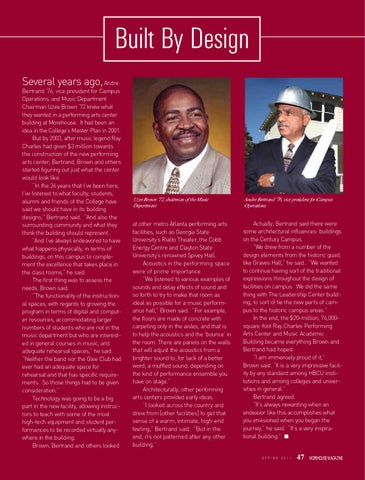Built By Design Several years ago,
Andre Bertrand ’76, vice president for Campus Operations, and Music Department Chairman Uzee Brown ’72 knew what they wanted in a performing arts center building at Morehouse. It had been an idea in the College’s Master Plan in 2001. But by 2003, after music legend Ray Charles had given $3 million towards the construction of the new performing arts center, Bertrand, Brown and others started figuring out just what the center would look like. “In the 26 years that I’ve been here, I’ve listened to what faculty, students, alumni and friends of the College have said we should have in its building designs,” Bertrand said. “And also the surrounding community and what they think the building should represent. “And I’ve always endeavored to have what happens physically, in terms of buildings, on this campus to complement the excellence that takes place in the class rooms,” he said. The first thing was to assess the needs, Brown said. “The functionality of the instructional spaces, with regards to growing the program in terms of digital and computer resources, accommodating larger numbers of students who are not in the music department but who are interested in general courses in music, and adequate rehearsal spaces,” he said. “Neither the band nor the Glee Club had ever had an adequate space for rehearsal and that has specific requirements. So those things had to be given consideration.” Technology was going to be a big part in the new facility, allowing instructors to teach with some of the most high-tech equipment and student performances to be recorded virtually anywhere in the building. Brown, Bertrand and others looked
Uzee Brown ’72, chairman of the Music Department
Andre Bertrand ’76, vice president for Campus Operations
at other metro Atlanta performing arts facilities, such as Georgia State University’s Rialto Theater, the Cobb Energy Centre and Clayton State University’s renowned Spivey Hall. Acoustics in the performing space were of prime importance. “We listened to various examples of sounds and delay effects of sound and so forth to try to make that room as ideal as possible for a music performance hall,” Brown said. “For example, the floors are made of concrete with carpeting only in the aisles, and that is to help the acoustics and the ‘bounce’ in the room. There are panels on the walls that will adjust the acoustics from a brighter sound to, for lack of a better word, a muffled sound, depending on the kind of performance ensemble you have on stage.” Architecturally, other performing arts centers provided early ideas. “I looked across the country and drew from [other facilities] to get that sense of a warm, intimate, high-end feeling,” Bertrand said. “But in the end, it’s not patterned after any other building.”
Actually, Bertrand said there were some architectural influences: buildings on the Century Campus. “We drew from a number of the design elements from the historic quad, like Graves Hall,” he said. “We wanted to continue having sort of the traditional expressions throughout the design of facilities on campus. We did the same thing with The Leadership Center building, to sort of tie the new parts of campus to the historic campus areas.” In the end, the $20-million, 76,000square-foot Ray Charles Performing Arts Center and Music Academic Building became everything Brown and Bertrand had hoped. “I am immensely proud of it,” Brown said. “It is a very impressive facility by any standard among HBCU institutions and among colleges and universities in general.” Bertrand agreed. “It’s always rewarding when an endeavor like this accomplishes what you envisioned when you began the journey,” he said. “It’s a very inspirational building.” ■
S P R I N G
2 0 1 1
47
MOREHOUSE MAGAZINE
